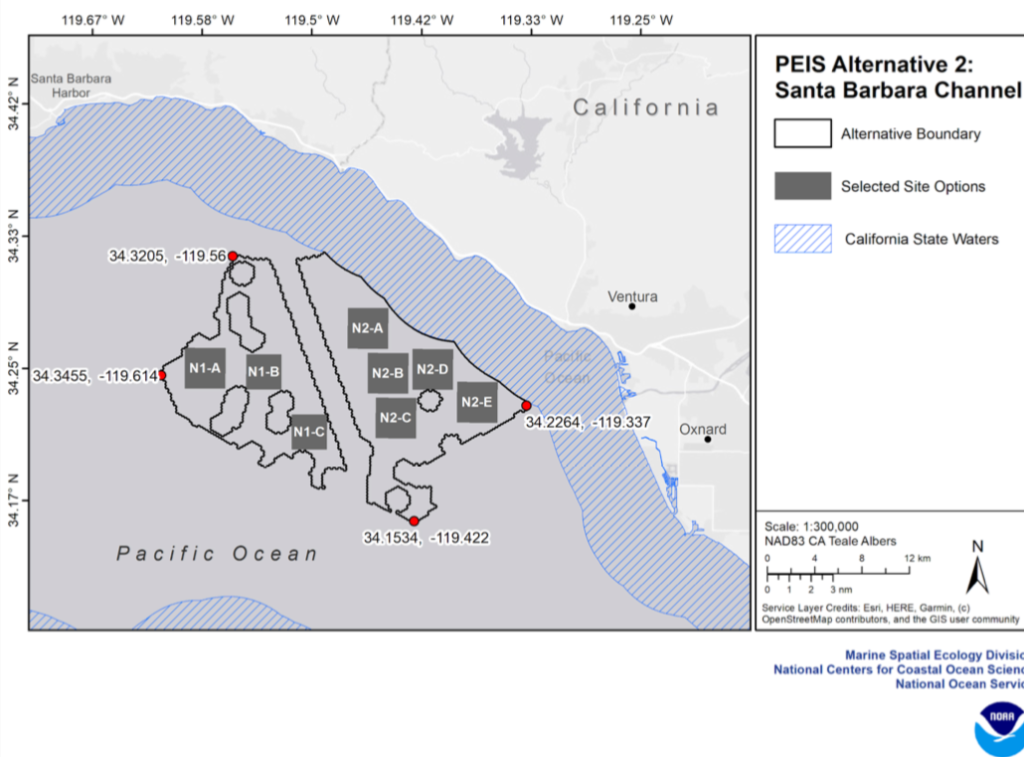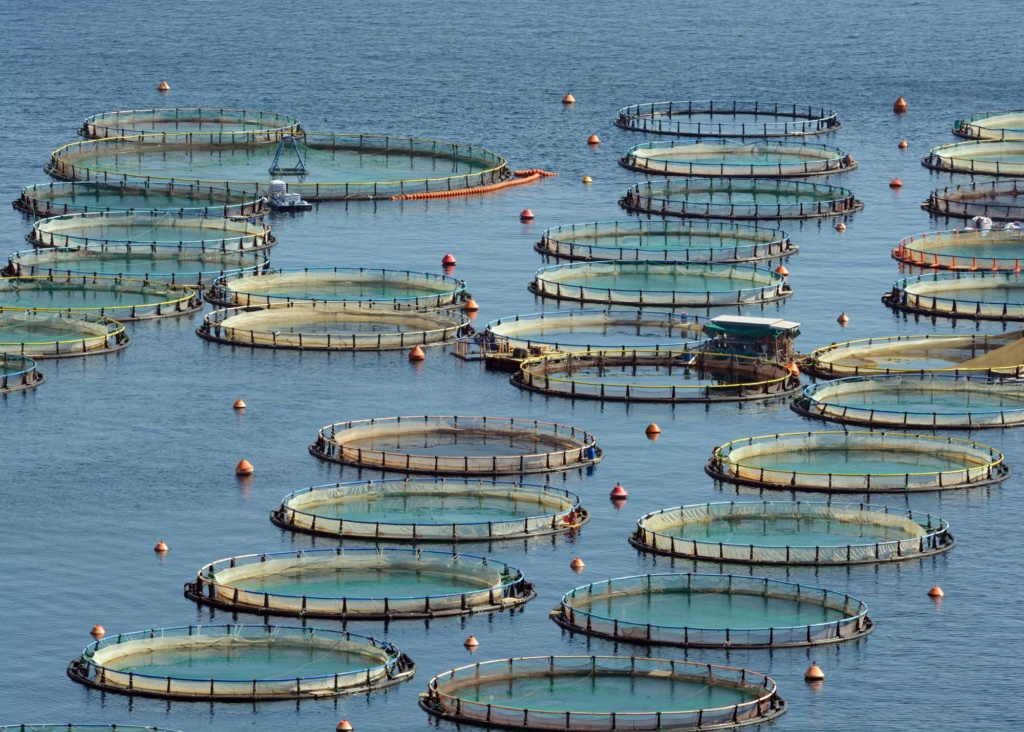As the Santa Barbara Channel confronts the unprecedented threat of new, industrial-scale aquaculture, now is the time to defend our coastal waters.
Federal agencies, led by the National Oceanic and Atmospheric Administration (NOAA), are currently advocating for the expansion of industrial-scale aquaculture, and have put forward a proposal to establish up to eight “Aquaculture Opportunity Areas” (AOAs) in the Santa Barbara Channel.

AOAs are geographic areas that have been evaluated to determine their suitability for commercial aquaculture. The eight AOA sites proposed for the Santa Barbara Channel could span up to 15,000 acres. These sites are all located in Federal Waters, outside of the state’s jurisdiction. Their proximity to sensitive habitats, fishing grounds, and critical migration corridors raises serious concerns about long-term environmental, social, and economic impacts.
In November, NOAA released a Draft Programmatic Environmental Impact Statement (DPEIS) analyzing the impacts associated with the proposed development of these AOAs. The document evaluates four distinct alternatives for potential development.
While aquaculture presents opportunities to address food security challenges, the DPEIS lays the foundation for rapid industrial-scale aquaculture development, rather than a balanced, environmentally conscious, and sustainable approach.
The DPEIS does not include a robust regulatory framework for monitoring, enforcement, and contingency planning, leaving the Channel vulnerable to unchecked risks. More safeguards are needed to ensure the proposed AOAs do not cause irreversible damage.

Potential Impacts to the Santa Barbara Channel
Large-scale aquaculture has been linked to a range of environmental issues including water pollution, disease transmission, genetic contamination, and habitat degradation.
- Nutrient pollution from fish waste, uneaten feed, and antibiotics could create pollution hot spots at and near the sites, adding to harmful algal blooms that suffocate marine life by depleting oxygen levels and degrading vital habitats.
- Infrastructure like net pens and longlines pose additional threats, increasing the risk of entanglement for marine mammals, sea turtles, and seabirds. These structures can also smother benthic habitats and threaten biodiversity.
- The escape of farmed fish, particularly non-native or genetically modified species, can spread disease, outcompete native populations, and disrupt ecosystem stability.
Make Your Voice Heard
Community input during the review process of the DPEIS is imperative to protect the waters and extraordinary biodiversity along our coast from the impacts of industrial-scale aquaculture. NOAA is organizing listening sessions on January 23 and 28 and accepting written public comments until February 20. We invite you to join us in taking action.
As the Santa Barbara Channel confronts the unprecedented threat of new, industrial-scale aquaculture, now is the time to defend our coastal waters. We believe that new aquaculture should prioritize sustainability and the long-term health of our Channel.
Ways to Get Involved:
- Attend Public Listening Sessions: Find info, meeting links, and registration here. (Scroll to Southern California section)
January 23, 2025, 1:00–3:00 PM PT
January 28, 2025, 5:00–7:00 PM PT
- Email comments to socalaoa.wcr@noaa.gov with the subject line “Southern California AOA DPEIS Comments.”
- Mail written comments to:
Celia Barroso
Regional Aquaculture Coordinator, California
National Marine Fisheries Service
West Coast Region
501 W. Ocean Blvd., Ste. 4200
Long Beach, CA 90802
Sample Letter:
Dear Ms. Barroso,
I am writing to express concerns about the proposed Aquaculture Opportunity Areas (AOAs) in the Santa Barbara Channel. The scale and location of the proposed AOAs threatens our environment, local fisheries, and coastal communities.
The Santa Barbara Channel’s strong currents, storms, and winds make it a vulnerable site, unsuitable for large-scale industrial aquaculture infrastructure. Pollution, habitat destruction, and entanglement risks posed by aquaculture in the Santa Barbara Channel can harm precious marine ecosystems. Increased vessel traffic and escaped fish have the potential to disrupt the livelihoods of local fishermen who rely on healthy, productive waters.
Prioritizing industrial aquaculture over sustainable, community-based solutions, could cause lasting harm to the Channel’s ecology and economy. I urge NOAA to reduce the scale of AOAs, avoid sensitive areas, prohibit offshore finfish farming, and move towards sustainable aquaculture practices that balance food production with environmental health.
Thank you for considering these comments.
Sincerely,
(your name)
Talking Points:
- Smaller, Well-Sited AOAs
I believe that the size and number of AOAs should be reduced. They should not be located near sensitive habitats and critical migration routes due to the risk of habitat degradation and entablement.
- Prohibit Offshore Finfish Aquaculture
Until robust safeguards are in place, I oppose offshore finfish farming due to its significant risks to water quality, wildlife, and ecosystems.
- The Channel is not Well-suited for Commercial Aquaculture
Because of the large waves, strong currents, and damaging winds that frequent the channel, industrial aquaculture is not well suited for this volatile environment. I believe that developing industrial scale aquaculture in the Santa Barbara Channel could lead to compounding impacts from escaped fish, debris pollution, and unforeseen environmental impacts.
- Strengthen Oversight and Monitoring
I would like to see a requirement for any aquaculture project to have centralized oversight, robust monitoring, and adaptive management plans to ensure transparency and accountability. - Promote Sustainable Alternatives/Small-Scale Aquaculture
I am in support of small-scale, well-managed shellfish and macroalgae farming, because it has the potential to offer ecosystem benefits like water filtration and carbon sequestration if done responsibly.
